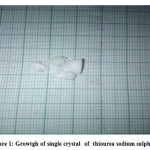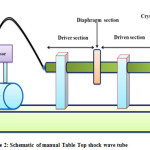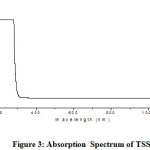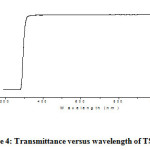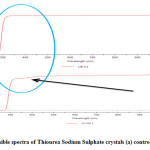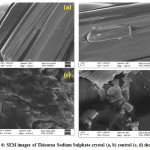Synthesis and Characterization of SEM, UV absorption coefficient and shock wave properties of Thiourea Sodium Sulphate crystal
M. Uday Bhaskar1* , S. Senthilkumar2 and G. Shankar3
, S. Senthilkumar2 and G. Shankar3
1Department of Physics, Research & Development Center, Bharathiar University, Coimbatore, Tamilnadu, India.
2Department of Basic Sciences, Kongu polytechnic college, Perundurai, Erode, Tamilnadu, India.
3Department of Physics, Thiruvallur college of arts and science, Rasipuram, Salem, Tamilnadu, India.
Corresponding Author Email: udaymphil@gmail.com
DOI : http://dx.doi.org/10.13005/msri/170309
Article Publishing History
Article Received on : 6-October-2020
Article Accepted on : 7-Nov-2020
Article Published : 10 Dec 2020
Plagiarism Check: Yes
Reviewed by: Dr. Venkata Sreenivas Puli
Second Review by: Dr. shivangini saxena
Final Approval by: Prof. K. M. Garadkar
Article Metrics
ABSTRACT:
Single crystal of Thiourea Sodium Sulphate (TSS) was prepared by a slow evaporation technique. The optical absorption and absorption coefficient are studied by UV. Vis.-NIR The voids or defects of the TSS crystal were carried out by its surface morphology analysis by SEM. The NLO properties of shocked TSS single crystal were estimated by UV-Vis-NIR spectroscopic analysis. Finally the nonlinear optical property of TSS crystal was estimated by Second Harmonic Generation (SHG) and the suitability of present titled mono crystal against mechanical resistivity after the shock for non linear optics and for photonic application has been confirmed.
KEYWORDS:
NLO; Optical Band Gap; SHG; SEM; Shock Wave; TSS
Copy the following to cite this article:
Bhaskar M. U, Kumar S. S, Shankar G. Synthesis and Characterization of SEM, UV absorption coefficient and shock wave properties of Thiourea Sodium Sulphate crystal. Mat. Sci. Res. India; 17(3).
|
Copy the following to cite this URL:
Bhaskar M. U, Kumar S. S, Shankar G.Synthesis and Characterization of SEM, UV absorption coefficient and shock wave properties of Thiourea Sodium Sulphate crystal. Mat. Sci. Res. India; 17(3). Available from: https://bit.ly/2LiXPc5
|
Introduction
NLO is a new era of science that is to play a vital role in the emerging technology of photonics even on nano applications, which is the technology of the 21st century. Nonlinear optical phenomena provide the conversion of frequency and optical switching [1-2]. Application of NLO depends on UV, refractive index, reflectance, extinction and absorption coefficient, dielectric constant and loss measurements etc. The impact of shock waves on the morphology and structural modifications from anatase to rutile phase. Organic NLO materials are attracting effectively [3-4]. The organic compounds could give benefits apart from the above include amenability for synthesis, higher resistance to optical damage for photonic device applications. Second-order NLO organic materials are most often based on π-conjugated molecules with strong electron donor and acceptor groups at the ends of the π-conjugated structure[6].In the present study it was focused on the impact of shock waves on the single crystal of TSS to evaluate its suitability for upcoming photonic devices and surface morphology.
Materials and Methods
Instrumentation
The basic chemicals were purchased from nice and spectrum chemicals, India the chemicals are melted using ctp temperature bath and its correspondence apparatus. The UV analysis was carried out by using LAMBDA 35 Spectrophotometer and SEM analysis is done by using make of CARELEVO18 at Archbishop Casmir Instrumentation Center (ACIC), St. Josephs College, Trichy, India. The shocks given to the sample using manual table top shock wave tube located at, Department of Physics, Sacred Heart College, Tirupattur, Tamilnadu, India.
Synthesis of single TSS crystal
To grow a mono crystal of TSS, the technique of slow evaporation method is applied. The solution was prepared by dissolving a required compound at stoichiometric ratio 1:1 in distilled water by taking the molecular weights of both thiourea and sodium sulphate are 7.612gms and 14.204gms and the total molecular weight of the material (After preparation of the sample in 100ml of water) is 21.816gms. The solution was constantly stirred for 2 hours using magnetic stirrer later it was filtered using Whatman filter paper and then allowed to evaporate at room temperature. The purity of the synthesized salt was improved by successive re-crystallization process. Finally well developed, good transparent crystal was obtained in the span of 32 days at room temperature is as shown in Fig.1 and the grown crystal was given 50 shocks using manual table top shock wave tube as shown in Fig.2.
Figure 1: Growtgh of single crystal of thiourea sodium sulphate.
Figure 2: Schematic of manual Table Top shock wave tube.
Results and Discussion
Optical absorption
The Figure 3 shows that the absorption and wavelength spectrum were plotted in the wavelength region 190–1100 nm. It is found that the selected material is translucent and these could be used as applications of non linear optical gadgets. From the figure 3 it is shown that the renounce wavelength of thiourea sodium sulphate crystal appears at 345nm. It is evident that well non linear optical material has an transparent optical nature at lower renounce wavelength range 200 to 400 nm.
Figure 3: Absorption Spectrum of TSS Crystal.
Optical transmission
Figure 4: Transmittance versus wavelength of TSS crystal
UV-Visible spectral analysis reveals vital report about transition of electrons of the crystal. The optical nature of TSS specimen was studied by incorporating UV-Vis spectrophotometer in the region of wavelength 200–1200 nm. The cut-off wavelength of the crystal is located around at 345 nm range. It is observed from the above crystal that the TSS has high transmittance in the entire visible region hence this material could be well facilitate as applications of non linear optical devices.
Shock Wave Analysis
UV-Vis-NIR analysis of TSS crystal
Figure 5: UV-Visible spectra of Thiourea Sodium Sulphate crystals (a) control (b) shocked.
Fig.5 shows the control and shocked crystals’ optical transmittance over the wavelength region between 200 and 800nm. Fig.5a shows the control sample’s optical transmittance profile and from the obverted transmittance profile, it is clear that the test crystal has wide optical transmittance window in-between 300 and 800 nm region. Hence, the test crystal is well suitable for non-linear optical applications. Fig.5b shows the shocked crystal’s optical transmittance over the wavelength region 200-800 nm. Unexpectedly, at shocked conditions, we observe reduction of optical transmittance and there is a strong signature of new absorption band at 350 nm. The appearance of the new absorption band by the impact of shock waves clearly demonstrates that the applied shock waves have significantly altered the electronic energy levels of the title crystal. The observed optical properties clearly reveal that the title crystal has less optical stability against the impact of shock waves. Hence, it is not a right candidate for the device applications in harsh environments [10].
SEM Analysis of TSS Crystal
Scanning electronic microscopy is one of the supreme tools to investigate the surface morphology of the microscopic scale materials. Hence, in the present case the SEM images were recorded for different magnifications. we have performed SEM technique to monitor the surface morphological changes on Thiourea Sodium Sulphate crystals and the observed SEM micro-graphs are presented in Fig.6. Before arriving at the discussion of shock wave induced morphological effects, it is essential to understand the control sample morphological patterns and its nature. As seen in Figs.6a and 6b, the control sample has good crystalline nature such that well ordered rectangular needle like morphological patterns are evident and the rectangular patterns confirm the growth of the crystal from 2D nucleation mechanism [11]. It is evidenced that the lack of visible defects, cracks, voids etc. Hence, from the observed SEM micro graphs, we could confirm that the test crystals have good crystalline nature. Figs.6c and 6d show the shocked crystal’s micro-graphs and the observed micrographs reveal lots of difference compared with the control sample’s micro-graphs. Shocked crystal’s micro-graphs portray lot of tiny crystals and it may be due to the breakage of one crystal to multiple tiny crystals by the impact of shock waves and the formation of tiny crystals may be due to the low mechanical stability of the test crystal. From the observed results, it can be concluded that the test material has low shock resistant nature due to low mechanical stability against the impact of shock waves.
Figure 6: SEM images of Thiourea Sodium Sulphate crystal (a, b) control (c, d) shocked.
Second Harmonic Generation studies of TSS crystal
The adaptability of SHG was calculated by deploying Kurtz-Perry powder method [12].The powdered specimen was packed thickly in a micro-capillary tube. It was mounted in the path of the laser pulse of energy 9.6-mJ, drawn by isolate the authentic laser beam. The output light was sent through a monochromator transmitting only the second harmonic (green) light at 532nm.
Conclusion
The single crystals of thiourea sodium sulphate grown successfully by the method of slow evaporation cooling at various temperatures. The optical transmission of the crystal affirms the translucence of the crystal and the in the present research work. It is concluded that the shocked TSS crystal reveals that the TSS crystal has less optical stability as it is clearly observed through the formation in to tiny crystals by its morphological images against the impact of shock waves. Hence, it is not a right candidate for the device applications in harsh environments. The results of SEM analysis of control and shocked samples reveal that control sampler surface morphology and the shocked TSS has lot of voids and defects, hence it concluded that the test material has low shock resistant nature due to low mechanical stability against the impact of 50 shocks only. At last the SHG for the TSS compound proposed that the Single crystal of thiourea sodium sulphate is advisable for fabrication of nano-materials, Photonics devices.
Acknowledgment
I am grateful to Department of physics Thiruvallur college of arts and science, Rasipuram, Salem, Tamilnadu, India for the development of sample and synthesis and preparation.
Funding Source
This research received no specific grant from any funding agency.
References
- Paras N. Prasad, David J. Williams, Introduction to nonlinear optical effect in molecules andpolymers, John Wiley & Sons, Inc. 1991.
- Tanusri Pal, Tanusree Kar, Gabriele Bocelli, and Lara Rigi, Synthesis, Growth, and CharacterizationOf l-Arginine Acetate Crystal: A Potential NLO Material, Cryst. Growth Des, 2003, 3, 13-16 2, https:// doi.org/10.1021/cg025583y
CrossRef
- Razzetti C, Ardoino M, Zanotti L, Zha M, Paorici C, Cryst. Res. Technol, Solution Growth andCharacterisation of L‐alanine Single Crystals, 2002, 37,456 https://doi.org/10.1002/1521- 4079(200205).
CrossRef
- Kalaiarasi S, Sivakumar A, Martin Britto Dhas S A, Jose M, Materials Letters, Shock wave induced anatase to rutile TiO2phase transition using pressure driven shock tube, 2018,219,72-75, https://doi.org/10.1016/j.matlet.2018.02.064.
CrossRef
- Mojca Jazbinsek, Lukas Mutter, Peter Gunter, IEEE Selected topics in quantum electronics, 2014, 24, 5, 1298-1310, 0.1109/JSTQE.2008.921407.
CrossRef
- John Xavier.K.V, Spectrochimica Act A 60, 2005, 79.
- Anieroshan, Ayttiyachan, Material Letters, Growth and characterization of a new metal-organic crystal: potassium thiourea bromide, 2001, 49(5), 299-302,https://doi.org/10.1016/S0167-577X (00)00388-8.
CrossRef
- Fedrous Akther, Jibban podderA Study on Growth, Structural, Optical and Electrical Characterization of L-alanine Single Crystal for Optoelectronic Devices, Research Journal of Physics, 2012, 6: 31-40, https://dx.doi.org/10.3923/rjp.2012.31.40.
CrossRef
- Sivakumar A, Saranraj, Martin Dhas, Sahaya S, Material Research Express, Structural, Optical and morphological stability of ZnO nano rods under shock wave loading conditions 2019,6(4), https://doi.org/10.1088/2053-1591/aafae6.
CrossRef
- Sivakumar, Saranraj A, Sahaya Jude Dhas S, Jose M, Martin Britto Dhas S A, Enhancement of the ptical properties of copper sulfate crystal by the influence of shock waves, Journal of Material Research Optical, 2020, 35(4,) 391-400,https://doi.org/10.1557/jmr.2019.383
CrossRef
- Kurtz S K., Perry T T, Journal of Applied Physics, 1968, (39)8,
CrossRef
- Rode M N, Hussania S, Muley G, Pawar B, Shirsat S, Optoelectronic and Advanced Materials-Rapid Communications, 2008, 2(1), 855- 858.

This work is licensed under a Creative Commons Attribution 4.0 International License.
 , S. Senthilkumar2 and G. Shankar3
, S. Senthilkumar2 and G. Shankar3 Material Science Research India An International Peer Reviewed Research Journal
Material Science Research India An International Peer Reviewed Research Journal

